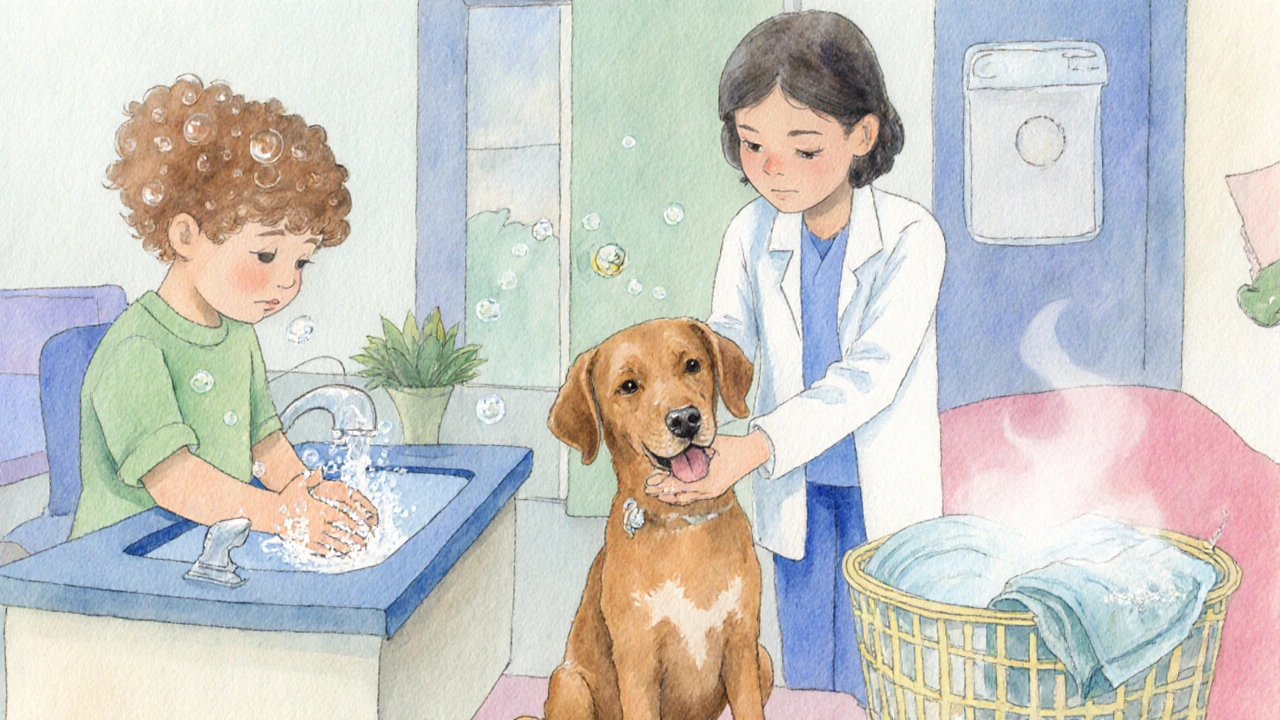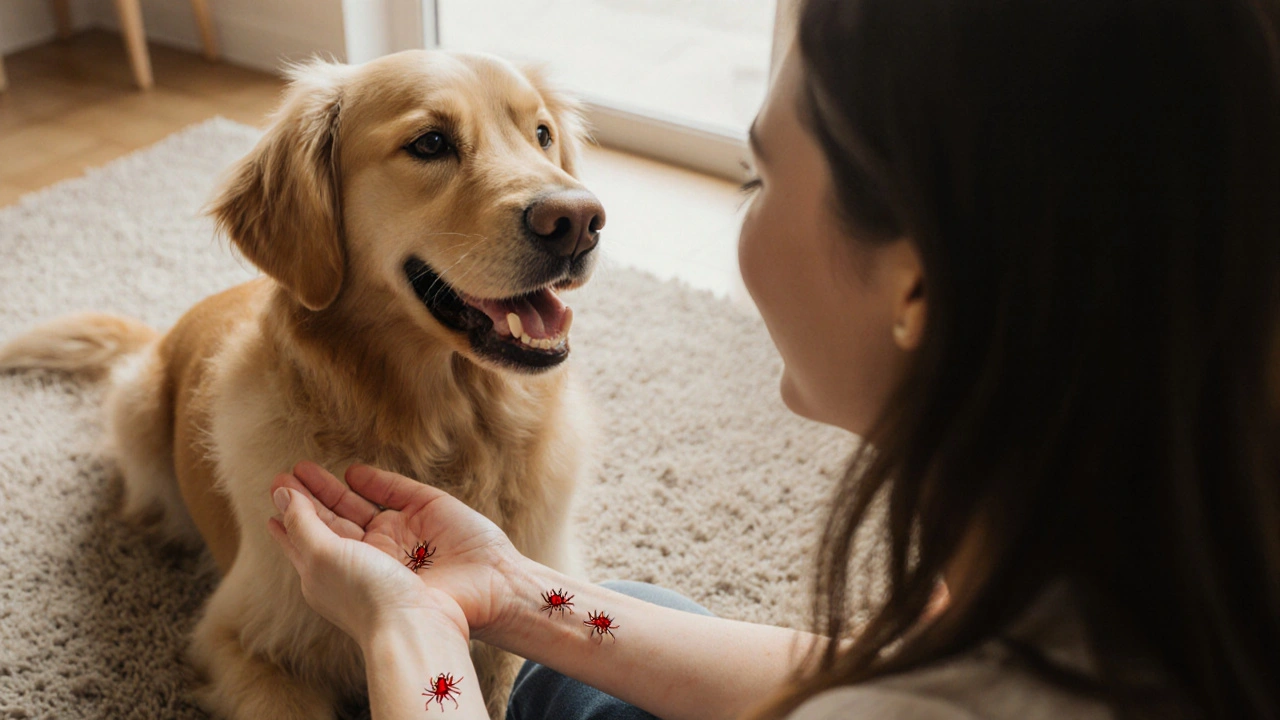Pet Skin Parasite Transmission Risk Calculator
Skin parasites can easily transfer from pets to humans through direct contact with contaminated fur, soil, or bedding. This calculator helps estimate risk levels based on common pet care practices.
High-risk behaviors include frequent outdoor access without protection, poor grooming schedules, and infrequent parasite checks.
Enter your pet's care details and click "Calculate Risk Level" to see your risk assessment.
- Low Risk 1-2
- Moderate Risk 3-4
- High Risk 5-6
When you notice itchy red bumps after playing with your dog or cat, you might be dealing with skin parasites tiny organisms that live on or lay eggs in the outer layers of human skin. Pets can act as silent carriers, bringing these organisms into homes where they spread to people. Understanding how pet skin parasites move from fur to flesh helps you protect your family and keep your companions healthy.
TL;DR
- Dogs and cats can carry mites, hookworm larvae, fleas and chigoe fleas that cause skin infections in humans.
- Most skin parasites are transmitted by direct contact with contaminated fur, soil or bedding.
- Regular veterinary deworming, flea control and good hygiene cut the risk dramatically.
- Seek medical help if itching lasts more than two weeks or you see moving burrows under the skin.
- Keep a simple checklist at home to spot early signs in pets and people.
What Counts as a Skin Parasite?
In everyday language, "parasite" can mean anything from a tapeworm inside the gut to a mosquito that bites you. For this article we focus on organisms whose life stage occurs in or on the skin. They either live there (like mites) or lay eggs that hatch and migrate through the skin (like hookworm larvae). The main groups include:
- Mites - tiny arthropods that dig tunnels or feed on skin cells.
- Fly larvae - also called maggots; some species burrow into the skin to develop.
- Hookworm larvae - microscopic worms that penetrate intact skin when they sense warmth.
- Fleas and chigoe fleas - insects that lay eggs on the host or in the environment; their larvae can cause skin irritation.
How Pets Become Carriers
Pets pick up these parasites in three common ways:
- Environmental exposure: Dogs that love digging in sand, soil or beach areas can pick up hookworm larvae (Ancylostoma braziliense a zoonotic hookworm that infects the skin of humans). The larvae stick to fur and later transfer to a person’s hands.
- Direct contact with other animals: Shelters, grooming salons and dog parks are hot spots for mites like Sarcoptes scabiei the mite that causes scabies. A single infested dog can spread the mite to many companions.
- Infestation of the pet itself: Fleas (Ctenocephalides felis the cat flea that also bites dogs and humans) and chigoe fleas (Tunga penetrans the sand flea that burrows into the skin) lay eggs in the pet’s coat. When the eggs hatch, the larvae can wander onto human skin.
Because many of these parasites can survive off‑host for days to weeks, simply having a pet that’s infested creates a reservoir in your home.
Common Skin Parasites Linked to Pets
Below is a quick snapshot of the most frequently encountered culprits.
| Parasite | Scientific name | Typical pet host | How it reaches humans | Skin sign |
|---|---|---|---|---|
| Scabies | Sarcoptes scabiei | Dogs, cats, wildlife | Direct skin‑to‑skin contact | Intense itching, burrow tracks |
| Demodex | Demodex canis / Demodex cati | Dogs, cats | Rarely zoonotic; over‑growth on human hair follicles can cause rosacea‑like rash | Red papules, especially on face |
| Cutaneous larva migrans | Ancylostoma braziliense (hookworm) | Dogs, cats | Larvae penetrate bare skin after walking on contaminated ground | Wriggling, serpiginous rash |
| Chigoe flea infestation | Tunga penetrans | Dogs, occasionally cats | Flea embeds in the skin, releasing eggs | Raised nodule with a central black point |
| Flea bite reaction | Ctenocephalides felis | Dogs, cats | Flea bites on human skin | Small red bumps, often on ankles |

Transmission Pathways - What Actually Happens?
Knowing the exact steps helps you break the chain. Here’s a typical route for two of the most common parasites:
Scabies from a dog
- The dog picks up Sarcoptes scabiei while sniffing another animal.
- Mites burrow a few millimetres under the dog’s skin, causing mild itchiness.
- When you cuddle or pet the dog, the mites transfer to your skin.
- Within 24‑48hours, they start tunnelling under your epidermis, creating the classic burrow tracks.
- The cycle repeats when you touch other family members or your own bedding.
Cutaneous larva migrans from sandy beaches
- Dog runs on a beach contaminated with hookworm eggs from other dogs.
- Eggs hatch into infective larvae that cling to the dog’s paws and fur.
- You walk barefoot on the same sand; the warm, moist skin triggers the larvae to penetrate.
- Larvae migrate a few millimetres a day, leaving a winding, itchy track.
Both scenarios illustrate two key points: environmental contamination and direct skin contact are the main drivers.
Prevention - Keeping Pets and People Safe
Prevention works best when you tackle both the pet and the home environment.
For pets
- Regular deworming: Follow a veterinary schedule (usually every 3‑6months) that covers hookworms and roundworms.
- Flea & tick control: Use a vet‑approved topical or oral product year‑round. In Melbourne, a monthly spot‑on treatment works well.
- Routine skin checks: Look for excessive scratching, hair loss or tiny black dots (ticks).
- Vaccinations & health checks: Some shelters screen for sarcoptic mange before adoption.
For the household
- Wash pet bedding weekly in hot water (≥60°C) to kill eggs.
- Vacuum carpets and upholstery regularly; discard the vacuum bag safely.
- Avoid letting pets lick open wounds or the face of infants.
- If you live near beaches or rural areas, wear shoes and gloves when handling soil or sand.
For personal hygiene
- Wash hands with soap after petting, grooming or cleaning litter boxes.
- Shower immediately after beach walks, especially if you went barefoot.
- Apply a barrier cream on exposed skin before outdoor activities in high‑risk zones.
When to Seek Medical Help
If you notice any of the following, book a doctor’s appointment:
- Intense itching that doesn’t improve with over‑the‑counter antihistamines.
- Visible burrow tracks (thin, wavy lines) on the arms, hands or feet.
- Red nodules that grow larger or develop a central black dot (possible chigoe flea).
- Fever, swelling or secondary bacterial infection at the rash site.
Doctors may take a skin scraping, a small biopsy or a simple visual exam to confirm the parasite. Treatment usually involves topical creams (for mites), oral antiparasitic pills (for hookworm larvae) or antihistamines for flea bite reactions.
Quick Checklist - Spotting and Stopping an Outbreak
- Check pet’s coat weekly for fleas, ticks or signs of mange.
- Inspect any rash on family members for burrows or serpiginous tracks.
- Ensure pet is on a current deworming and flea‑control schedule.
- Wash hands and change out of outdoor clothes after beach or garden work.
- If a skin issue persists beyond 10days, consult a clinician.
Takeaway
Pets bring joy, but they can also bring tiny hitchhikers that like to live or lay eggs in skin. By understanding the life cycles of Sarcoptes scabiei, Ancylostoma braziliense and other culprits, you can break the chain before a minor itch turns into a full‑blown outbreak. Regular vet visits, solid flea‑control, and simple hygiene habits are the three‑pillars that keep both humans and their furry friends itch‑free.

Frequently Asked Questions
Can cats transmit scabies to humans?
Yes, although cats are less common carriers than dogs, they can harbor Sarcoptes scabiei and pass it on through close contact. Prompt veterinary treatment and good hand‑washing habits prevent spread.
What’s the difference between fleas and chigoe fleas?
Fleas (Ctenocephalides felis) live on the pet’s blood and bite humans occasionally. Chigoe fleas (Tunga penetrans) actually embed themselves into the skin, swell, and release eggs that fall to the ground. Their bites appear as a raised nodule with a dark centre.
Is cutaneous larva migrans dangerous?
It’s not life‑threatening, but the creeping rash can be extremely uncomfortable and may become infected if scratched. A single dose of albendazole or ivermectin clears the infection quickly.
How often should I deworm my dog?
In Australia, veterinarians recommend a deworming schedule every 3‑6months, with additional treatments if the dog frequents beaches, farms or dog parks where hookworm eggs are common.
Can humans get Demodex from pets?
Human Demodex (Demodex folliculorum) is a different species that lives on our own skin; it’s not transmitted from pets. However, a heavy Demodex over‑growth on a dog can signal a weakened immune system, which may make the pet more susceptible to other skin parasites that can affect humans.

Tiarna Mitchell-Heath
If you think your cute pup is just a harmless cuddle buddy, you’re dead wrong – those sneaky skin parasites love hitching a ride on fur and will jump onto you the moment you pet them.
Katie Jenkins
Actually, the literature shows that the primary vectors are fleas and mites, which transfer via direct contact, not "just" via fur. According to the CDC, regular baths and flea preventatives cut the risk by up to 90%. Also, be aware that indoor‑only zones drastically reduce exposure. So, if you’re serious about preventing skin parasites, stick to a weekly grooming schedule and check your pet’s coat daily.
Jack Marsh
While the data you cite is accurate, it overlooks the fact that many owners skip grooming because they consider it optional. The reality is that even with perfect bathing routines, outdoor exposure to contaminated soil can re‑introduce parasites. Moreover, the risk calculator you referenced assumes uniform compliance, which is rarely the case in real households.
Steven Waller
When we examine the ecology of ectoparasites, we must begin with the host’s environment. Pets that roam freely in parks or backyard lawns encounter reservoirs of flea larvae and tick nymphs, which can survive for weeks in leaf litter. The life cycle of these organisms is exquisitely adapted to exploit warm, humid microhabitats often found in residential gardens. Consequently, a pet that spends several hours outdoors daily is effectively a mobile incubator, constantly re‑seeding the household with potential pathogens.
Regular grooming does more than just keep the coat shiny; it physically removes adult parasites before they can lay eggs. However, grooming alone cannot compensate for a lack of preventive medication. Modern topical and oral treatments act systemically, breaking the reproductive cycle of fleas and destroying ticks before they can attach long enough to transmit disease.
Indoor‑only policies also play a crucial role. By restricting a pet’s access to the outside, owners dramatically reduce the probability of initial infestation. Even a partially restricted indoor area, such as keeping the pet out of bedrooms, can lower the human‑to‑pet transmission vector, especially for children who are more likely to handle bedding and furniture.
Human skin is a surprisingly hospitable environment for certain parasites, particularly Sarcoptes scabiei, which can cause scabies in both animals and people. This cross‑species compatibility makes personal hygiene paramount. Frequent hand‑washing after handling pets, especially before eating, is a simple yet effective barrier.
Lastly, the psychological component should not be ignored. Owners who are aware of the risks are more likely to adhere to preventive regimens. Education, therefore, is the first line of defense, and tools like risk calculators serve to translate abstract statistics into actionable daily habits.
Puspendra Dubey
Wow, that was a masterclass in parasite apocalypse-my heart’s still pounding after reading about flea‑infested backyards and invisible critters plotting world domination!
Shaquel Jackson
Honestly, I think most people overreact. A quick check once a month and a dab of flea spray should be enough. No need to become a parasite‑detective.
Tom Bon
While a minimalist approach works for some, the data suggests that a consistent, monthly inspection schedule dramatically reduces the chances of unnoticed infestations. It’s a small time investment for peace of mind.
Clara Walker
Did you know those “pet‑care” companies are in on it? They sell you cheap flea meds while feeding the hidden agenda of keeping us dependent on their products. Wake up, sheeple!
Jana Winter
Technically, the statement “they’re feeding a hidden agenda” is unsubstantiated. The efficacy of FDA‑approved flea treatments is documented in peer‑reviewed studies, which have demonstrated a reduction of infestation rates by over 95% when applied correctly.
Linda Lavender
Picture this: a tiny, invisible army of mites marching across your couch, waiting for the perfect moment to pounce on unsuspecting skin. The drama of it all is enough to make anyone double‑check their pet’s fur before it’s too late.
Jay Ram
Exactly! Let’s channel that energy into daily checks. A quick swipe with a comb each morning can catch early infestations before they become a full‑blown crisis. You’ve got this!
shikha chandel
All this chatter about parasites is a distraction from the real issue: the government’s hidden labs test these critters on pets.
Mary Ellen Grace
Pets love belly rubs.
Kelly Larivee
Keeping dogs clean and checking them often is simple. It helps keep everyone safe.
Emma Rauschkolb
Utilizing prophylactic ectoparasiticides constitutes a cornerstone of integrated pest management, thereby mitigating zoonotic transmission vectors and preserving dermal homeostasis across host species.
Landmark Apostolic Church
Contemplating the symbiotic dance between pet and parasite invites us to reconsider the very definition of coexistence; perhaps the goal isn’t eradication but harmonious balance.